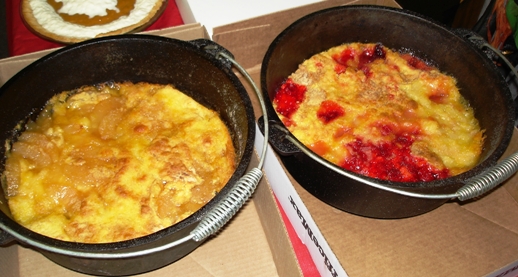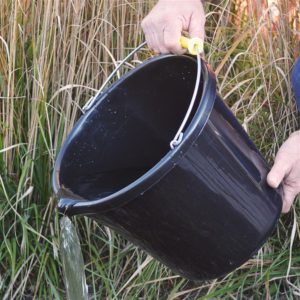
Editor’s Note: Each May, we celebrate the annual Dutch Oven Gathering at Lehman’s store in Kidron, Ohio, where cast iron cooking devotees came from far and wide to cook up delicious treats for visitors to sample. Those unable to attend: this article’s for you! It includes helpful tips on getting started with dutch oven cookery, plus an easy (and yummy) recipe to try. Happy cooking!
In many ways you could say a Dutch oven is the ultimate cookware. For the resident barbecue “expert” who might feel he or she has perfected the grill, taking up cast iron cooking opens up a whole new world of mastering the cook fire for the enjoyment of family and friends. For the burgeoning cook who wants a new challenge, a Dutch oven can be a creative way to adapt both old and new recipes. I could go on and on, but the fact is cooking in Dutch ovens is just FUN.
I was first introduced to Dutch oven cooking some 20 years ago when I joined a frontier reenactment organization that was a fellowship of a ministry group at my church. While portraying an early 1800s westward frontiersman, I learned how to shoot a flintlock rifle, throw a tomahawk and knife and erect a teepee, but most importantly I learned to cook over an open fire with techniques far beyond the average modern-day campground visitor.

History
By the time American frontiersmen carried cast iron pots west into the wilderness to prepare and transport food, the Dutch oven had been popular for 150 years. The Dutch people are not credited for inventing deep metal cooking pots, but history shows their system of making the cast metal cookware was far more advanced than other areas of the world. They developed a technique for using dry sand to make molds, giving their finished cast pots a much smoother surface.
According to the history books, an Englishman by the name of Abraham Darby traveled to the Netherlands and learned the system. Four years later, in 1708, he patented the technique for making cast iron pots. Some say that’s how the pots became known as “Dutch ovens.”
When the first colonists arrived in the New World, they brought Dutch ovens with them. Over time legs had been added to the bottom to hold the pot above the fire coals. A handle, or bail, was added to suspend the pot from a hook over a flame and carry it while hot. Another improvement came when a small lip was added to the lid to better hold coals for true “oven” cooking.

At this time I have three Dutch ovens in my cook set, along with a dozen or so cast iron skillets of different sizes, a griddle, a bacon press, and cooking accessories including a lid lifter, heat resistant gloves, and other related items. Two of my ovens have legs and a flanged lid for open flame or coals cooking, while the third has no legs and a rounded top, sometimes referred to as a stew pot. It works just like the other ovens, but is suitable for a stovetop or sitting on a wire rack inside a modern oven.
Why Dutch Ovens?
A huge benefit of Dutch ovens and cast iron cookware is that they will last several lifetimes if handled properly. They last so long, in fact, that stories are told of families in the eighteenth and nineteenth centuries noting in a will who would inherit their ovens. President George Washington’s mother, Mary Ball Washington, reportedly specified in her will that her “iron kitchen furniture” would be divided equally between two grandchildren. Adventurers Lewis and Clark carried Dutch ovens during their westward exploration in 1804 to 1806, as did the Mormons who migrated to the Salt Lake Valley region of Utah in the 1850s.
There’s plenty more examples of Dutch oven use throughout history, but the fact remains that they’re just as handy today as they were 300 years ago. When properly seasoned and maintained a quality oven will be nearly as “non-sticking” as the modern Teflon or other coated cookware. Cleanup is exceptionally easy — never use harsh detergents or scratch pads, and always re-coat with a thin layer of oil between uses.
What to Cook
The list of foods that can be prepared in a Dutch oven is endless. They’re equally capable of making stews or soups; cooking small game or domestic fowl; making breads or biscuits; preparing breakfast dishes or desserts. Anything you can bake in a modern day oven, you can bake in a Dutch oven. My primary oven has been used to prepare venison and beef stew, Cornish hens and vegetables, homemade biscuits and cornbread, and too many dump cakes (see below) to remember. They can be used with coals, an open flame or a modern kitchen cook stove.
You say your family doesn’t have Dutch ovens that have been passed down from generation to generation? No problem. Quality new ovens are being made and sold in the same manner they have been for three centuries. As with many things, new technology has improved on something even as simple as the cast iron Dutch oven. Many companies such as Lehman’s now offer pre-seasoned ovens straight out of the box.
 To finish, here’s an easy recipe for a mouthwatering dessert any beginner can prepare. It’s often the first baked good that new Dutch oven cooks try. It’s extremely simple, but doesn’t taste like it.
To finish, here’s an easy recipe for a mouthwatering dessert any beginner can prepare. It’s often the first baked good that new Dutch oven cooks try. It’s extremely simple, but doesn’t taste like it.

Dutch Oven Dump Cake
Ingredients
- 1 box white or yellow cake mix
- 1 large can cherry, pineapple or apple pie filling
- 1 stick butter or margarine
- 1/2 can Sprite or other clear (lemon-lime) soda
Instructions
- Dump dry cake mix into seasoned Dutch oven.
- Empty can of pie filling in on top of dry mix.
- Cut up and disperse pads of unheated butter across top of filling.
- Empty portion of clear soda into ingredients.
- Using a spoon or other utensil, insert it into the layered ingredients and make a couple “Figure 8″ stirs. Do NOT mix ingredients thoroughly.
- Put the lid on the oven.
- If baking over coals, preheat approximately 24 charcoal briquettes in a grill or charcoal starter chimney.
- Place nine coals beneath the oven and 15 on the lid.
- Let cake bake for approximately 45 minutes, rotating the oven clockwise and the lid counter-clockwise – turn every 15 minutes to distribute heat evenly.
- If using a conventional modern cook stove oven, pre-heat oven to 300 degrees and place Dutch oven on middle shelf.
- Bake for approximately 45 minutes.
- Remove oven from heat, remove lid and let cool partially before serving.
Nutrition
- Serving Size: 8
Editor’s Note: This post was originally published in January 2012.






























It strikes me that these recipes and tips can also be use with my solar oven. It easily gets up to 300 to 350 degrees which should be plenty to bake in one of my inherited dutch ovens. One has a glass lid which I think will work very well for solar cooking.